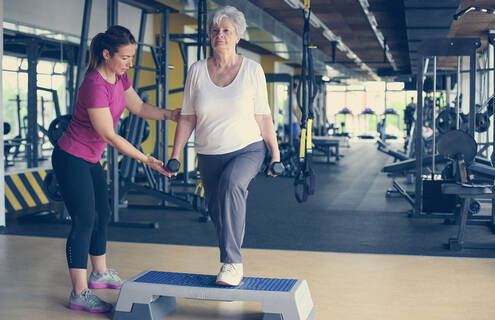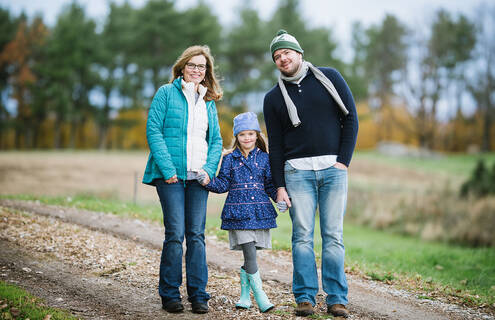
Some might say muscle mass is in a race against time.
While muscle mass and strength increase steadily from birth, it peaks around age 30 to 35. After age 50, women lose 5% to 10% of their muscle mass each decade. Muscle power and performance decline slowly and linearly at first, and then faster after age 65.
Fortunately, weightlifting can buffer against these hormonal changes by strengthening your body and improving your long-term health.
"We don't just hit menopause and turn into a saggy bag of skin and bones. We can still gain muscle mass, but we just really need to work at it."
The power of your body's strength
Weightlifting will help you build muscle, increase strength and gain balance and agility. It's the only way to slow the muscle loss process, maintain muscle and potentially gain muscle after menopause.
"I recommend weightlifting across the board. The gains older people can make are incredible," says Peter M. Loescher, MD, our sports medicine physician at Dartmouth Health's Alice Peck Day Memorial Hospital. "It's truly never too late to start and benefit from a weightlifting program."
The loss of estrogen leads to a reduction in bone density and an increased risk of osteoporosis.
"Weight training helps combat your decrease in estrogen," says Sarah C. Bent, DPT, our physical therapist at DHMC.
You can build your strength by using free weights, resistance bands or by doing weight-bearing exercises, like walking, jumping or climbing stairs.
A 2024 study found that women who strength train two to three days a week are more likely to live longer and have a lower risk of death from heart disease compared to women who do none.
Strength training may also ward off neurological conditions like Alzheimer's and dementia, according to a 2023 study.
"The more we can get the blood pumping through the body, the lower our risk is going to be for things like Alzheimer's, dementia and cardiovascular disease," Bent says.
Subscribe to the Living Better newsletter
Your trusted resource for reliable and up-to-date health and wellness information in the Northeast. Get it delivered to your inbox every other week.
Your balance will improve, too
Building strength can also help stimulate your metabolism, protect your joints, burn more calories and lower the chance of falls and injuries.
With strength comes balance, and vice versa, Karlson says.
"It's a combination deal," she says. "The younger person who stumbles on a crack in the sidewalk is going to catch themselves and not fall. But the older person without strength will stumble and go straight down."
Another way to help with balance and coordination are exercises like standing on one foot in the grocery store check-out line or at the bathroom sink when brushing your teeth, Karlson suggests.
Free weights vs. weight machines
When weightlifting, Dartmouth Health experts recommend using free weights—barbells or dumbbells—instead of weight machines at the gym.
"Machines at the gym don't help with balance. You want to stand using dumbbells—whether it's doing lunges, squats or arm curls—to build your strength and balance," Loescher says.
Experts advise exercising both sides of your body evenly. For example, weight machines at the gym, like a chest press or leg curl machine, don't always encourage equal use of your arms or legs.
"If you use a leg press, you could be favoring a stronger leg and not even realize it," Karlson says. "Some people might need to use machines because they have some asymmetries that they can't correct from an old injury or a stroke. But in general, if you're using barbells or dumbbells, you're forced to work on balance and strength at the same time."
And if you're worried about weightlifting giving your muscles a bulky appearance, experts say that likely won't happen. What weightlifting will do is help you lose weight and gain definition.
"Weightlifting when you're older is more about function than how it makes you look," Bent says. "Aesthetic improvements as you begin to work out are always nice to see. But make sure you're focusing on weightlifting as something that's good for your body, heart, mind, bones and blood."
Getting started
"Building muscle doesn't happen magically like it does for younger people. Some people will gain muscle mass more easily than others," Karlson says. "We're all different, and as you get older it might take longer to see results."
Try to exercise each muscle group at least twice a week, with a minimum of two days of rest between workouts. Use lower-pound weights by doing two to three sets of 12 to 15 repetitions at a time.
Karlson says if you don't want to buy weights or join a gym, find a beginner weightlifting tutorial on YouTube. She also suggests using household items like soup cans, water bottles or firewood to practice lifting if you don't have weights at home.
"Start by using something that weighs around three pounds and work your way up," Karlson says.
You'll likely feel a difference about six weeks after starting a weightlifting program.
Bent says if you're new to weightlifting, consider hiring a personal trainer or schedule an appointment with a physical therapist to learn proper form and avoid injury.
"It's never too late to get started," Bent says. "Come up with a schedule that's realistic to you. Starting small is much more effective than starting with a big ambitious plan that's unsustainable and might lead to an injury."


